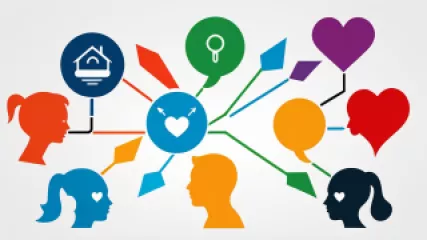The Ultimate Guide to Understanding Attachment in Adults
Introduction
Attachment theory, originally developed by psychologist John Bowlby, is often associated with the parent-child bond. However, attachment patterns and dynamics continue to shape our relationships well into adulthood. Understanding attachment in adults can provide profound insights into our behaviors, emotions, and interpersonal connections.
In this ultimate guide, we will delve into the fascinating world of attachment in adults. We will explore the different attachment styles, the impact of early experiences on adult relationships, and how attachment-based therapy can help individuals cultivate healthier connections. Whether you're seeking personal growth or professional knowledge, this guide will equip you with a comprehensive understanding of attachment in adults.
Table of Contents
- Attachment Styles
- Impact of Early Experiences
- Attachment in Adult Relationships
- Attachment-Based Therapy
- Healing and Growth
- Nurturing Secure Attachments
Attachment Styles
Attachment styles are patterns of behavior and emotional responses that develop in childhood and persist into adulthood. These styles influence how individuals perceive and engage in relationships. There are four primary attachment styles:
- Secure Attachment: Individuals with secure attachment feel comfortable with intimacy and autonomy. They trust their partners, express emotions openly, and have healthy boundaries.
- Avoidant Attachment: People with avoidant attachment tend to avoid emotional closeness and may struggle with intimacy. They value independence, downplay emotions, and may feel uncomfortable with vulnerability.
- Anxious Attachment: Individuals with anxious attachment seek high levels of closeness and validation from their partners. They often worry about abandonment, display intense emotions, and may become overly dependent.
- Disorganized Attachment: Those with disorganized attachment may exhibit conflicting behaviors and emotions. They may have experienced trauma or inconsistent caregiving, leading to confusion and difficulty regulating their emotions.
It's important to note that attachment styles are not fixed, and individuals can develop more secure attachment through self-awareness and therapeutic interventions.
Impact of Early Experiences
Early experiences, particularly interactions with primary caregivers, play a significant role in shaping attachment patterns. The quality of care received during infancy and childhood influences an individual's beliefs about themselves and others. These beliefs form the foundation for future relationships.
Children who experience consistent love, support, and responsiveness from their caregivers are more likely to develop secure attachment styles. They learn that their needs will be met, and they can trust others. On the other hand, children who experience neglect, abuse, or inconsistent parenting may develop insecure attachment styles.
Insecure attachment styles can manifest in various ways. Avoidant attachment may result from caregivers who were emotionally unavailable or dismissive of their child's needs. Anxious attachment may stem from inconsistent caregiving, where a child learned to fear abandonment due to unpredictability. Disorganized attachment often arises from traumatic experiences or unresolved conflicts within the family system.
While early experiences shape attachment, it is essential to remember that attachment patterns can be modified through self-reflection, therapy, and supportive relationships.
Attachment in Adult Relationships
Attachment patterns established in childhood continue to influence our adult relationships. Our attachment styles impact how we communicate, relate to others, and navigate conflicts. Let's explore how different attachment styles manifest in adult relationships:
- Secure Attachment in Adult Relationships: Adults with secure attachment styles tend to have fulfilling, balanced relationships. They feel comfortable expressing their needs, providing support to their partners, and maintaining healthy boundaries.
- Avoidant Attachment in Adult Relationships: Individuals with avoidant attachment may struggle with emotional intimacy in their relationships. They may prioritize independence, struggle with vulnerability, and find it challenging to fully commit to a partner.
- Anxious Attachment in Adult Relationships: Those with anxious attachment often seek constant reassurance and validation from their partners. They may experience jealousy, worry about abandonment, and have difficulties trusting their partners.
- Disorganized Attachment in Adult Relationships: Adults with disorganized attachment may exhibit unpredictable behaviors and emotional outbursts in relationships. They may struggle with regulating emotions, have difficulty with conflict resolution, and may experience fear of both intimacy and abandonment.
Understanding your own attachment style and that of your partner can enhance empathy, communication, and overall relationship satisfaction. It allows for more conscious choices and the opportunity for personal growth.
Attachment-Based Therapy
Attachment-based therapy is an approach that focuses on exploring and healing attachment-related wounds. This therapy modality aims to promote secure attachment and improve individuals' overall well-being. Here are some key components of attachment-based therapy:
- Exploration of Attachment History: Therapists help individuals examine their attachment history, identifying patterns and exploring the impact of early experiences on their adult relationships.
- Developing Self-Awareness: Attachment-based therapy helps individuals develop self-awareness by understanding their emotions, needs, and relational patterns.
- Building Secure Attachment: Therapists guide clients in developing secure attachment by cultivating trust, establishing healthy boundaries, and enhancing emotional regulation skills.
- Healing Trauma: For those with disorganized attachment resulting from trauma, attachment-based therapy provides a safe space to process and heal unresolved traumatic experiences.
- Improving Communication: Attachment-based therapy focuses on enhancing communication skills, fostering empathy, and promoting effective conflict resolution strategies.
Attachment-based therapy can be beneficial for individuals seeking personal growth or those experiencing challenges in their relationships. Working with a qualified therapist can provide the necessary support and guidance throughout the therapeutic process.
Healing and Growth
Understanding attachment in adults opens up opportunities for healing and personal growth. By becoming aware of our attachment styles and the underlying dynamics, we can make conscious choices to cultivate healthier relationships.
Here are some strategies for healing and growth:
- Self-Reflection: Engage in self-reflection to identify patterns, triggers, and areas of growth. Explore how your attachment style influences your thoughts, behaviors, and emotions.
- Therapy: Consider seeking therapy, particularly attachment-based therapy, to work through unresolved attachment-related issues and develop more secure attachments.
- Developing Emotional Intelligence: Enhance your emotional intelligence by learning to identify and regulate your emotions effectively. This skill can improve your relationships and overall well-being.
- Establishing Boundaries: Set clear boundaries in your relationships to ensure your needs are met and respected. Communicate your boundaries assertively and honor those of others.
- Practicing Mindfulness: Cultivate mindfulness practices to become more present and attuned to yourself and your interactions with others. Mindfulness can help you respond rather than react based on past attachment patterns.
- Seeking Support: Connect with supportive friends, family, or support groups that can provide a safe space for sharing experiences and receiving validation.
Remember, healing and personal growth are ongoing processes. Be patient and compassionate with yourself as you navigate your attachment journey.
Nurturing Secure Attachments
Nurturing secure attachments in adult relationships requires ongoing effort and commitment. Here are some tips to cultivate and maintain secure attachments:
- Open and Honest Communication: Foster open and honest communication with your partner. Express your needs, concerns, and emotions in a respectful and non-confrontational manner.
- Practice Empathy: Cultivate empathy by genuinely seeking to understand your partner's perspective and validating their emotions. Empathy strengthens the emotional connection between partners.
- Prioritize Emotional Availability: Make a conscious effort to be emotionally available for your partner. Show up consistently, actively listen, and provide support when needed.
- Develop Trust: Build trust through consistent actions and keeping your promises. Trust is the foundation of secure attachments.
- Embrace Vulnerability: Allow yourself to be vulnerable with your partner. Share your fears, dreams, and insecurities, fostering a deeper emotional connection.
- Respect Autonomy: Recognize and respect each other's autonomy and individuality. Encourage personal growth and maintain healthy boundaries.
- Cultivate Intimacy: Nurture intimacy through physical affection, quality time together, and engaging in activities that promote emotional closeness.
- Seek Support When Needed: If challenges arise, don't hesitate to seek professional help or couples therapy. Addressing concerns early can prevent further strain on the relationship.
By implementing these strategies, individuals can create and maintain secure attachments, fostering fulfilling and harmonious adult relationships.
Conclusion
Attachment in adults is a complex and profound topic that sheds light on our behaviors, emotions, and relationships. Understanding our attachment styles and the impact of early experiences empowers us to make conscious choices, heal past wounds, and nurture secure attachments.
Whether you're embarking on a personal journey of self-discovery or seeking ways to improve your relationships, the knowledge gained from this ultimate guide can provide valuable insights and guidance. Remember, attachment is a lifelong process, and with awareness and effort, we can cultivate healthier and more fulfilling connections.






